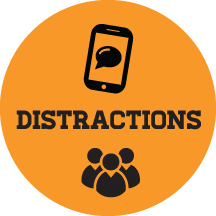By Maddie Graham
We know all of you have been harped about texting and driving as much as your mom tells you to wash the dishes. It’s everywhere: on billboards, safety messages at school, even advanced car technology that prevents cell phone use while driving. However, distracted driving is a much larger issue than just texting. According to the National Highway Transportation Safety Association (NHTSA), distracted driving is defined as “any activity that diverts attention from driving, including talking or texting on your phone, eating and drinking, talking to people in your vehicle, fiddling with the stereo, entertainment or navigation system – anything that takes your attention away from the task of safe driving.”
There are three different types of distractions that a driver can engage in:
- Manual: physically taking your hands off the wheel. Manual distractions include eating, drinking, putting on makeup, adjusting passengers or pets in other parts of the vehicle, etc.
- Visual: taking your eyes off the road. Visual distractions can include staring at billboards, wrecks, your GPS, texting and driving, looking in the mirror, etc.
- Cognitive: taking your mind off driving. Even though you are physically capable of driving, make sure your emotions are in check before you get behind the wheel. If you are crying, anxious, overwhelmed, mad, or feel any other strong emotion, pull over and deal with your emotions before operating a motor vehicle.
All three of these types of distractions are equally important and can result in a crash, injury, or even death. In 2016 alone, 3,450 people died in distracted driving related motor vehicle crashes. Additionally, 391,000 people were injured. According to NHTSA, teens were the highest driving group to engage in distracted driving and had the highest number of distracted related fatalities. On top of everything, these numbers are highly under-reported, due to the fact that it is difficult for police to determine if the crash was related to distracted behaviors or not.
Photo courtesy of https://www.idrivesafely.com/defensive-driving/trending/distracted-driving-fact-sheet
So, while you are on the road to your friend’s house, remember these safety tips to avoid driving distracted:
- Talk to your passengers about the importance of safe driving before you start the car. According to the NHTSA, 57% of all automobile crashes occurred when the driver was talking to a passenger, compared to 12% caused by texting and driving. Let your passengers know that you need to focus on the road, and to keep the distractions to a minimum. No loud music or yelling until you get to your friend’s house safely!
- Put away that cell phone! Ok, I know we beat this one to death. You should already be very much aware of the dangers of texting and driving. This one is a no brainer! You don’t want your friends texting and driving when you are a passenger, so have the same respect for them. Your passengers can be the designated DJ!
- If driving with children or pets, make sure everyone in the vehicle is secure and won’t move during the trip. Don’t let your dog sit in your lap, this is very unsafe. Make sure all pets are put away in a carrying cage. You want to make sure your furry best friend makes it back home alive!
- Don’t eat in the car. Eat before you leave if you are hungry.
- Program your GPS and your playlists before you start driving. Que up a number of songs so that you don’t have to be messing with your phone during the trip.
- Remember Murphy’s Law: Anything that could go wrong, will go wrong – like unexpected traffic! A lot of these distractions originate from being late, such as putting on makeup, self-grooming, eating, or drinking. Always plan for extra time to get from point A to point B so that you won’t have to be speeding to your destination and end up engaging in these dangerous behaviors.
